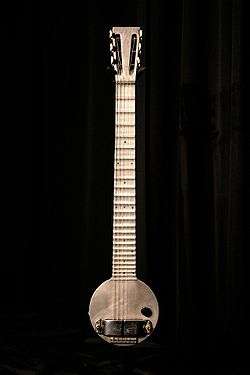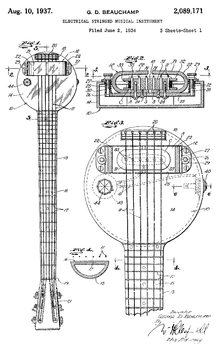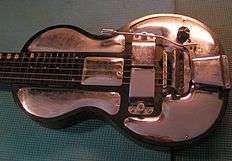Frying pan (guitar)
The "Frying Pan" is the first electric lap steel guitar. Developed in 1931/1932, it received its patent in August 1937.[1] A previous attempt, the Stromberg company‘s transducer-based "Stromberg Electro", was introduced in 1928. It used a "vibration-transfer rod" from the instrument's sounding board attached to magnets inside the guitar, and was not successful.[2] George Beauchamp created the "Fry-Pan" in 1931, and it was subsequently manufactured by Rickenbacker Electro. The instrument—officially the Rickenbacker Electro A-22—earned its nickname because its circular body and long neck make it resemble a frying pan.
| Frying pan | |
|---|---|
 | |
| Manufacturer | Ro-Pat-In Company (later renamed to Rickenbacker) |
| Period | 1931/1932 – 1939 |
| Construction | |
| Body type | Cast aluminum |
| Neck joint | Set |
| Woods | |
| Body | Cast aluminum |
| Neck | Cast aluminum |
| Fretboard | Aluminum |
| Hardware | |
| Bridge | Aluminum |
| Pickup(s) | One Rickenbacker horse-shoe magnet pickup |
| Colors available | |
| Bare metal | |
It was designed to capitalize on the popularity of Hawaiian music in the 1930s. The instrument was made of cast aluminum, and featured a pickup that incorporated a pair of horseshoe magnets that arched over the strings. Beauchamp and machinist Adolph Rickenbacker began selling the guitar in 1932, but Beauchamp was not awarded a patent[3] for his idea until 1937, which allowed other guitar companies to produce electric guitars in the same period.
Development
In the 1930s, Hawaiian music enjoyed widespread popularity in the United States. However, Hawaiian music featured the guitar as the main melodic instrument, and the volume of acoustic guitars was insufficient for large audiences. Beauchamp, an enthusiast and player of Hawaiian music, mounted a magnetic pickup on his acoustic steel guitar to produce an electrical signal that was electronically amplified to drive a loudspeaker, producing a much louder sound. After discovering that his system produced copious amounts of unwanted feedback from sympathetic vibration of the guitar's body, Beauchamp reasoned that acoustic properties were actually undesirable in an electric instrument.
Beauchamp had helped develop the Dobro resonator guitar, and co-founded the National String Instrument Corporation. Through these businesses, he was acquainted with Rickenbacker, who owned the machine company that manufactured the aluminum resonators and brass bodies for the instruments. With Rickenbacker's help, Beauchamp designed a lap steel guitar with a solid aluminum body and neck. Rickenbacker produced the instruments from 1932 to 1939.
Gallery
_using_one-piece_maple.jpg) 1931 prototype
1931 prototype
(one-piece maple,
25" scale, 25 fret) 1932 Ro-Pat-In Elektro A25
1932 Ro-Pat-In Elektro A25
(one-piece aluminum cast, same size as prototype).jpg) 1934 Rickenbacker Electro A22 (22.5" scale, 23 fret)
1934 Rickenbacker Electro A22 (22.5" scale, 23 fret)
_%40_2010_TSGA_Jamboree.jpg) 1935 Rickenbacker Electro Hawaiian B6 (23 fret)
1935 Rickenbacker Electro Hawaiian B6 (23 fret) 1938 (or 1935) Rickenbacker Electro Vibrola Spanish Guitar (23 fret)
1938 (or 1935) Rickenbacker Electro Vibrola Spanish Guitar (23 fret)_%26_Rickenbacker_Electric_Spanish_Guitar_(1930s)%2C_Museum_of_Making_Music.jpg) 1930s Rickenbacker Electric Spanish Guitar (right)
1930s Rickenbacker Electric Spanish Guitar (right)
References
- Ross, Michael (February 17, 2015). "Pedal to the Metal: A Short History of the Pedal Steel Guitar". premierguitar.com. Retrieved September 1, 2017.
- Michael Wright (February 2000). "1000 Years of the Guitar, Part 2". Vintage Guitar.
- "ELECTRICAL STRINGED MUSICAL G. D. BEAUCHAMP et al" Google Patents, accessed June 14, 2011.